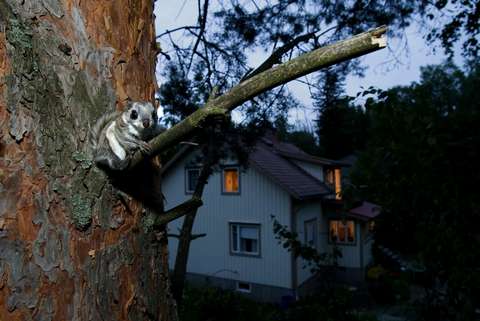Flying Squirrel LIFE project concluded – Espoo will continue to reconcile urban development and the protection of flying squirrels

A large international project to protect flying squirrels is now coming to an end. It provided Espoo with new information on how flying squirrels live and relevant urban planning solutions. The project showed that flying squirrels are doing better in the city than people thought.
The six-year Flying Squirrel LIFE project, funded by the European Union, provided Espoo with valuable information on how to protect endangered flying squirrels in a growing city.
"By 2060, Espoo could have 20,000 more residents than today. But the city must still have room for diverse nature. In this ambitious project, we learned that urban development and the protection of flying squirrels are possible at the same time,” says Project Manager Laura Lundgren, an environmental specialist.
Planning is effective: flying squirrels move in the planned areas
One of the project’s objectives was to examine how flying squirrels can be taken into account in local detailed plans. Espoo examined whether the plan symbols and regulations are effective in practice. In other words, whether the planned flying squirrel habitats and routes remained after construction.
“Our monitoring showed that flying squirrels were found in precisely the areas and routes that had been planned for them. Planning realises the conservation objectives,” says Lundgren.
Radio monitoring revealed that flying squirrels are adaptive
During the Finnish-Estonian Flying Squirrel LIFE project, Espoo tested new conservation measures and studied the lifestyles of flying squirrels. Radio monitoring was one method of obtaining data on the movements of flying squirrels.
"It turns out that flying squirrels live in smaller areas than we thought. They also proved to be less sensitive in terms of lifestyle than we expected. They are happy to nest in pine trees as well as deciduous trees, and two of the flying squirrels tracked by radio even visited apple trees in a courtyard in Espoo. The noise and light of the city do not seem to disturb flying squirrels,” says Lundgren.
One of the practical actions of the project was that Espoo strengthened flying squirrel routes by planting trees. Jumping posts were built in Finnoonlaakso with EU support to provide flying squirrels with more places to cross the Länsiväylä road.
In Hyljelahti, the city’s nature management unit tested ways to reconcile the needs of outdoor enthusiasts and flying squirrels in the management of the nearby forest.
“In areas that are important for flying squirrels, we favour spruce and aspens and ensure that they continue to grow in the forest for flying squirrels,” says forest manager Tiina Peippo from the city’s nature management unit.
Conservation work will continue after the project
Espoo is obliged to have a favourable conservation status: the city must continue to have at least as many flying squirrels as it has now, and young flying squirrels must have a habitat in which to roam. Following the end of the project, Espoo will continue to maintain tree saplings and jumping poles for at least 20 years and take the flying squirrels into consideration in all its planning of land use and nature management.
“Conservation is not always easy, but we are learning by doing. Protecting one species also benefits other forms of nature and makes the city better for people. Espoo residents are gratifyingly interested in the future of the flying squirrel,” Lundgren says.
Espoo will continue to discuss the lessons learned with other countries and cities.
“We do things as part of the Espoo community and in close cooperation between the city’s units. Espoo participates in international and national networks that jointly develop effective ways of protecting nature,” says Tarja Söderman, Director of Environmental Affairs.
Espoo's flying squirrel population is strong
An estimated 1,000–2,000 flying squirrels live in Espoo. Since 1995, the city’s nature surveys have identified approximately 3,500 nesting trees of flying squirrels. Flying squirrels have spread to the forests of northern Espoo and to the densely built southern Espoo.
Although the population is strong in Espoo, the flying squirrel is a nationally endangered species. The greatest threats to the species are the fragmentation and reduction of habitats.
The project has received funding from the European Union’s LIFE programme. The content of the material reflects the views of its authors and neither the European Commission nor CINEA is responsible for the use of the data contained in the material.